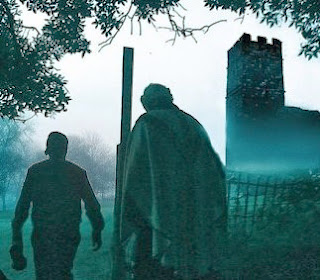An Englishman, Irishman and Scotsman go to a church... Graham Humphreys' poster art for THE BORDERLANDS ("Where faith goes to die.") For the film, unfriendly locals, a burning sheep and mysterious footage open up a bottomless pit of horror.
WHEN claims of a supernatural event are made at a remote church in the west of England, a Vatican-sanctioned team are sent to access the situation. Working under an organisation called The Congregation, Brother Deacon (Gordon Kennedy), Father Mark (Aidan McArdle) and technology expert Gray (Rob Hill) investigate the claims of Father Crellick (Luke Neal) that during a filmed baptism various religious artefacts are seen vibrating on an altar. Gray fits CCTV equipment to the church and the cottage where the trio are staying, with each of the members also wearing a headcam. As events take a darker turn with Crellick's suicide, the team start to question their own judgements when they - quite literally - start to travel into the labyrinthine bowels of hell.
The found footage sub-genre can be conceptually and technically limiting, but with the right dynamics the format can be greatly enhanced. Such is the case with first time writer/director Elliot Goldner's THE BORDERLANDS, which excels both as a character study and an exploration of Olde England. Kennedy and Hill make for an unlikely dynamic duo - Deacon is a gruff hard-drinking Scotsman answering to the Vatican, Gray a talkative agnostic Englishman only in it for the money - but the actors gel on screen (McArdle is a stilted Irish head of operations, and this viewer yearned to see Reece Shearsmith in the role). The use of headcams make for a smoother and more sensible ride than the obligatory handhelds, which seem to remain relatively intact whatever the situation in similar pictures. The surveillance cameras maintain an eerie perspective within the church - capturing a vibe which melds THE STONE TAPE with EXORCIST: THE BEGINNING - but there is also a fertile depth into a Pagan time of more tangible beliefs, against the modern era where we need to believe.
Like all memorable horror, THE BORDERLANDS' locations,
characters and themes form a successful whole.
characters and themes form a successful whole.
What can be best termed British rural horror is defined by two main characteristics: quietly sinister country locals (when asking for directions and ignored, Gray snipes back "give my regards to Edward Woodward") and foreboding ancient terrors - often subterranean. Even though the countryside and the elements portray a deft mythology, counterculture has added another layer since The Beatles included Aleister Crowley on the cover of Sgt Pepper in 1967. As Vic Pratt states in his Sight & Sound article 'Long Arm of the Lore' (October 2013), "folk custom, witchcraft and the occult were no longer absurdities; they might almost be an option."
Making exemplary use of locations in Denbury, South Devon, THE BORDERLANDS climax is filmed extensively at Chislehurst Caves, Kent. The caves themselves are enveloped with a rich history of uses; originally a 22-mile stretch of man-made chalk and flint mines, this popular tourist attraction acted as an ammunition depot in the First World War and mushroom cultivation in the 1930s. Built by Druids, Romans and Saxons, this colourful past led it to be a music venue used by the likes of the Rolling Stones and Pink Floyd, and Led Zeppelin's Swan Song label had a launch party there in October 1974. Additionally, they have been used in the DOCTOR WHO adventure THE MUTANTS, and substituted for an underground space headquarters in INSEMINOID.


